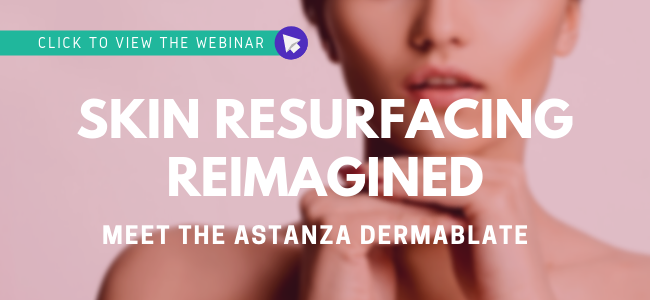 These days, there are so many different ways to improve the skin’s overall appearance: microneedling, chemical peels, skin resurfacing, laser treatments, IPL, dermabrasion, facials, and more.
These days, there are so many different ways to improve the skin’s overall appearance: microneedling, chemical peels, skin resurfacing, laser treatments, IPL, dermabrasion, facials, and more.
While it’s evident for patients to choose treatments best-suited for their needs, understanding which procedures are the most productive for achieving #skingoals can be challenging. In this article, we’ll take a look at two popular skin treatments, microneedling versus skin resurfacing with the DermaBlate Erbium:YAG laser. In doing so, we’ll outline the differences, pros and cons, ideal use cases, and more between microneedling and laser skin resurfacing and why the latter is the preferred choice for many patients and practitioners.
What is Microneedling?
Microneedling is an aesthetic procedure that involves puncturing the skin with very fine needles, pens, or rollers to create tiny holes in the skin. By creating tiny openings in the superficial layer of the skin, the goal is to stimulate collagen and elastin production and improve the appearance of skin tone, fine lines, wrinkles, minimal scarring, and other blemishes. Practitioners use needles of varying lengths, diameters, and arrangements, to treat the skin and stimulate superficial skin restructuring and growth. Microneedling has been in practice since 1995 and has gained popularity in recent years due to improved technology and social media exposure. The most commonly treated area is the face; however most skin areas can be treated with microneedling. Microneedling is minimally invasive and requires no downtime.
What to Expect During a Microneedling Treatment
Patients typically receive microneedling treatments at a medical spa, although some patients have found success with “dermarollers,” the at-home version of microneedling. Treatments can last approximately 30-45 minutes and are administered every 4-6 weeks until patients achieve their desired look. Patients interested in collagen stimulation typically need at least three treatments, whereas patients trying to correct the appearance of scars require a minimum of 3-6 visits. Although microneedling treatment isn’t too uncomfortable, patients may require topical numbing if the needles used are 1.5 mm or larger.
Does Microneedling Create Temporary or Lasting Results?
Microneedling alone can only create temporary results, lasting about 4 to 6 weeks following treatment. Although the effects are temporary, patients do see fairly immediate results. Following treatment, patients will notice their skin appear more plump, luminous, and bright. The skin tends to look more radiant and plump because of the inflammation and swelling triggered by the tiny puncture wounds. Alternatives to microneedling like laser skin resurfacing with the Astanza DermaBlate Er:YAG laser deliver longer-lasting results, but we’ll dive into that later.

Enhancing Microneedling with PRP and Radiofrequency
Practitioners have found a few different treatment cocktails to enhance microneedling and make the effects last longer. These include pairing microneedling with Platelet-Rich Plasma (PRP) therapy or Radiofrequency (RF) applications. The PRP treatment–so-called “vampire facial”–evokes imagery that stems from the dramatic, immediate post-treatment pictures. The principle behind this treatment is to infuse your pre-drawn plasma into tiny micrometer-sized channels, using the naturally-occurring nutrition in your blood to increase, speed up, and enrich the healing process. Patients should expect their skin to appear bloody during a PRP/microneedling session. Laser skin resurfacing delivers a more comfortable (and less messy) experience while delivering lasting results.
Radiofrequency (RF) functions a little differently. RF technology has its own merit of resurfacing and restructuring but is typically used to penetrate deeper into the skin. The theory behind utilizing RF with microneedling is treating the skin on multiple levels, from superficial to deep. So while they don’t necessarily aid each other’s function, they work in tandem to improve texture at numerous levels of the dermis and epidermis.
Microneedling Cost
The cost of microneedling will vary based on the number of sessions, whether you do the procedure at home or a clinic, and if you decide to do PRP with your treatment. Although at-home microneedling treatments are more affordable, patients usually notice they’re not as effective. This is because the microneedling devices your dermatologist or aesthetician have access to are higher-grade, and they’re able to couple your microneedling treatment with PRP or Radiofrequency (RF).
Pairing microneedling with one of these supplemental treatments makes the procedure more efficacious, but doing so increases the overall cost. In reality, the term “microneedling” can encompass a spectrum of individual procedures. While a singular microneedling session without PRP or RF can cost anywhere from $200 to $700. A patient might end up paying at least $4,000 by the end of their treatment package. Also, patients should be aware that if they’re seeking a more intensive microneedling treatment, they may require some form of numbing, further driving up the cost.
When Patients Should Try Microneedling
Although combining treatments with microneedling to increase its effects sounds enticing, it’s not usually the most cost-effective, long-lasting, or practical route for patients. Getting microneedling treatments administered regularly can improve skin texture and tone over time, but it’s definitely not the best method for achieving permanent skin improvement. Microneedling is great for patients interested in giving their skin a short-term boost. If you’re trying to look your best for a series of events, an upcoming vacation, or a quick ticket to a more refreshed, radiant look, treat yourself with a few microneedling treatments. However, don’t expect any long-term results with this temporary quick fix.
For Something More Effective than Microneedling, Try Skin Resurfacing with an Erbium:YAG Laser
While microneedling may be perfect for revitalizing your skin leading up to an event, it’s not the best option for creating lasting results for improved texture and tone. Some of the biggest drawbacks of microneedling are its less noticeable and very temporary effects. To truly “turn back time,” patients have found more success with Erbium:YAG laser treatments to reduce fine lines, wrinkles, and recapture the “glow” that skin loses over time.
Fractional Ablative Resurfacing with Erbium:YAG Lasers
Lasers have been used to vaporize skin tissue for over 40 years. The first lasers developed for aesthetic purposes were developed in the 1960s with the Ruby laser, targeting brown pigments, followed by Carbon Dioxide Lasers in 1978. Erbium:YAG lasers utilize the chromophore water to cause the greatest amount of vaporization possible to effectively treat and remove unwanted skin blemishes, both superficial and deep. The tissue is removed from the epidermis through vaporization, allowing for a slight contraction in the healing process. Along with vaporization, epidermal and dermal heating occurs, allowing for a coagulative reaction. This coagulation stimulates blood flow and healing, seeking to improve collagen and elastin networks in the extracellular matrix.
Like microneedling, it’s possible to manipulate laser resurfacing’s skin effects and intensity by modifying how energy is applied. You can use more energy to have a deeper effect, decrease the pulse duration to have a relatively more ablative shot, or increase the pulse duration to exaggerate that coagulative effect. Depending on the selected parameter, practitioners can dial in the exact reaction needed to garner the skin’s sought-after treatment.
Ablative lasers will generally come with two treatment tips, one for fractional treatments and another for full-field ablation. Fractional handpieces are used to treat large areas and reduce pigmentation, fine lines, wrinkles, or scars while allowing most of the skin to stay intact. The benefit of fractional treatments is the reduced downtime. Similar to microneedling, fractional treatments only cause trauma to a predetermined amount of tissue. For instance, the DermaBlate has several preset fractional settings: E10, C10, W25, N10, and N25. The numbers associated with each of these settings indicate the amount of coverage (i.e., 10% or 25%), and the letters in those parameters indicate the amount of energy used and the pulse duration. By manipulating the energy, pulse duration, and percent coverage, an Er:YAG laser can achieve the same results done by microneedling.
Additionally, the full-field ablation handpiece is best utilized in bulk tissue removal (i.e., skin tags, wart removal, etc.). This extra capability with a laser platform can make a large difference in a clinic’s procedures.
Learn More about Erbium:YAG Laser Technology
For practitioners interested in offering both gentle and deeper, longer-lasting treatments to improve skin texture and tone, we recommend the DermaBlate Er:YAG laser by Asclepion Laser Technologies based in Germany. The DermaBlate is the most powerful, versatile, and controllable Erbium laser in the world. It has been the top-selling Erbium laser for the past 20 years, preferred by leading dermatologists and plastic surgeons. The DermaBlate can exceed the power of CO2 laser treatments and mimic gentle, superficial microneedling treatments, all while surpassing these common methods in efficacy, safety, downtime, and limiting side effects. To learn more about how the DermaBlate is revolutionizing how practitioners treat different skin indications, click here or the link below. Only available in the US.









